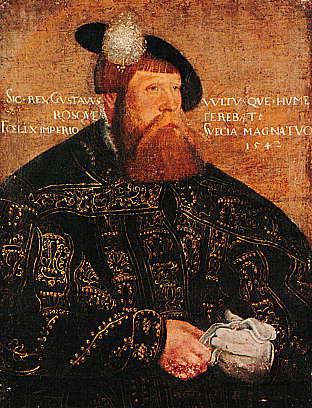”Sveriges
kyrkohistoria” is a multi-volume work in Swedish. The topic dealt with is
Swedish Church history, but “normal” history interferes essentially all the
time. This volume is subtitled “Reformationstid”. It deals with the most
interesting period in Swedish Church history, the 16th century, when
the Church of Sweden was transformed from a Roman Catholic Church province to
an independent confessional Lutheran Church.
The
Protestant Reformation in our northern lands wasn´t a straightforward affair
and took about 80 years to complete! One reason is that the Reformation took
place simultaneously with the transition from a relatively decentralized
medieval polity to a strongly centralized monarchy with absolutist tendencies. Add
to this the ambition of the Swedish ruling class to turn the small country into
a European great power. This meant heavier tax burdens and a military draft for
the peasants. The Church of Sweden supported the centralizing tendencies of the
monarchy, which in turn used Lutheranism as a political tool. The peasants
often identified the Reformation with the state, and hence wanted to remain Catholic
(or at least keep all the old traditions associated with medieval Catholicism
intact). The first Lutheran king of Sweden, Gustav Vasa, systematically confiscated
Church property, including valuables made of gold, silver or expensive
textiles. These had often been paid for by the tithes of the local peasantry,
which therefore saw the confiscations as an attack against the common people. The
largest peasant uprising against Gustav Vasa, the so-called Dackefejden led by
Nils Dacke from Småland, had strong Catholic overtones and was even promised
military aid by Catholic princes in Germany (in the end, none materialized). On
the other hand, Catholicism also had a certain degree of support among the high
nobility. This became especially obvious during the reign of Sigismund, who as
simultaneous king of Poland actually was a Catholic. The book says that it
probably wasn´t until around 1600 that the Swedish peasants had become used to the
new Lutheran order (and I suspect “superstitious” medieval traditions survived
even then).
The example
of Sigismund also shows another factor complicating the course of the Reformation:
Swedish foreign policy. Both Gustav Vasa and his successors had to navigate an
increasingly perilous international situation in which religious affiliation
was one – but only one – factor deciding who was allied to whom. Vasa was mostly
cautious and pragmatic in his dealings with foreign powers, and often impeded Lutheran
Church reforms in Sweden if he felt that a too militant posture would threaten
whatever diplomatic maneuvers he was involved with at the time. It´s interesting
to note that one of Vasa´s perennial enemies, Danish king (later ex-king)
Christian II, switched religious affiliation several times. Two Catholic
powers, Poland and the state of the Teutonic Knights, were “natural” allies of
Sweden (both were anti-Russian), while at least one Lutheran power, Denmark,
was a natural enemy. I get the impression that Gustav Vasa supported the
Reformation mostly because it gave him an opportunity to expand royal power and
strengthen the state. Economic issues also played a role, since king Gustav
believed that the Catholic prohibition to work on Sundays and various holy days
inhibited the productivity of the peasantry (and, I suppose, everyone else). His
sons Erik XIV, Johan III and Karl IX, by contrast, seem to have been more
genuinely interested in theological issues. Erik XIV and Karl IX were often
accused of Calvinistic tendencies by the orthodox Lutheran clergy, while Johan III
veered towards Catholicism. All insisted that the king should have the last say
in Church matters, both in terms of creedal statements and clerical appointments.
Some
situations described in the book are absurd, as when Erik XIV, his advisors and
the bishops discussed an acute crisis during the “Seven Year War” against
Denmark: the Danish blockade had made wine scarce, a problem since the Church
of Sweden celebrated the Eucharist with wine given to the laymen and insisted
that all masses must be Eucharistic. The lack of wine gave the Philippists (moderate
Lutherans) and Calvinists a welcome opportunity to argue their view of Holy
Communion, according to which the wine might just as well be replaced by water,
mead or cherry juice. (Celebrating communion with mead does have a certain intrinsic
appeal.) The orthodox Lutherans refused, and argued that wine simply must be
used cuz Bible, period. Erik XIV veered towards the Philippists and Calvinists,
but in the end a compromise solution was reached: it was allowed to mix water
with wine, as long as it still tasted like wine! King Erik subsequently managed
to procure a large quantity of real wine from Germany, thereby mooting the
whole issue…at least for the time being.
For making
my head spin, I give “Sveriges Kyrkohistoria. Band 3: Reformationstid” five
stars out of five!

Trolling leftists about the Dacke War could be funny. Do the leftists support Gustav Vasa, the "historically progressive" Protestant reformer who "developed the productive forces", or do they support the popular rebellion under Dacke, who was a Catholic? HA HA HA.
ReplyDeleteWell, comrades, what does Marxist theory say?
The liberals has already chosen sides. They seem to support Sigismund cuz Anti-Brexit or something.
Who do you support? The Philippists? You sperge about them all the time.
ReplyDelete